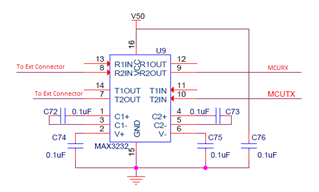I use the MAX3232 in several products as an interface between the onboard MCU and an external RS-232 bus. Recently I have received reports from customers that the product stopped communicating. When I received some units back for analysis I isolated the failure at the MAX3232. Interestingly, it is a partial failure - the RS-232 receiver is still functional but the transmitter has failed. I found this by observing the signals: A message can be seen to arrive from the RS-232 bus at RIN2 (pin 8) and the properly translated message leaves from ROUT2 (pin 9). The MCU processes the message and sends a response that can be seen arriving at DIN2 (pin 10). However, no corresponding RS-232 output is ever observed at DOUT2 (pin 7)!
Please help me understand what the possible causes of this failure might be. I have included a schematic of the MAX3232 as used in my circuit:


